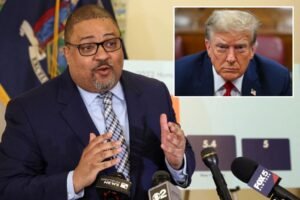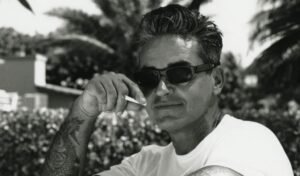
[ad_1]
New York Fashion Week’s Fall/Winter 2024 runways have officially come to a close, and fashion’s global showgoers have already landed in London for the English capital’s spin. With more than 65 names on the calendar, spanning stalwarts Willy Chavarria, Eckhaus Latta and Laquan Smith, as well as newcomers, including Ludovic de Saint Sernin, Jane Wade and Colleen Allen, the fashion fair showcased what’s to arrive on the industry’s shelves next season.
This time around, New York’s runways pushed the needle on menswear with a number of standout trends. Protective fashion pieces, like bulletproof vests and helmets, permeated the runways of Jane Wade, PUMA and Helmut Lang alike, while designers like LUAR, Ludovic de Saint Sernin and LaQuan Smith built a case for sheer shirting. There was a calm nature to many of the runways, and ultimately, the shining-star trend became practical wearability for several brands. Structured tailoring, too, defined much of the formalwear, spearheaded by the likes of Chavarria and Thom Browne, while neckties became cool and casual, en masse.
Below, Hypebeast rounded up five of the biggest menswear trends from New York Fashion Week FW24.
Protective Fashions
Many New York designers’ Fall 2024 collections put safety first, with ready-to-wear silhouettes and accessories designed to protect the human body.
Most notably, Peter Do’s second Helmut Lang collection, titled “Protection vs. Projection,” was defined by an abundance of key design details that intended to mask their wearers from harm’s way. Vests, bomber jackets and trousers were made with a new silk bubble-wrap textile that included bulletproof reinforcements. Wool coats and padded nylon puffers employed precautionary head coverings that, as Do noted in his collection notes with a lighthearted bullet point, “don’t mess up hair.” Knitwear was filled with padding, much like that of an astronaut suit.
Ludovic de Saint Sernin’s models, meanwhile, carried different forms of daggers in their hands. Several of the Paris-based designer’s ensembles included tightly-knotted leather headpieces that were stiffly wrapped around their wearers’ heads and faces, while others were protected in BDSM-inspired harnesses.
PUMA took the sportswear approach, debuting boulder-sized bowling bags and face-shielding sunglasses. Additionally, the brand put forth a number of body-covering silhouettes that zipped up to just below the nose and wrapped snugly around the head. The main event, though, was the biker helmets, which served a true purpose on the road.
Willy Chavarria’s collection, titled “Safe From Harm,” shielded several looks with veils, while much of its pieces took a more figurative approach to the danger-defying aesthetic. Jane Wade also contributed to the trend, with a number of skull-grabbing headpieces and bulky helmets.
Evidently, New York fashioners are prepared for any and all threats on the city’s streets.
Sheer Shirting
The see-through shirt has slowly but surely made its way to staple status in menswear over the last several seasons. For Fall 2024, several New York Fashion Week runways were rife with the liberating silhouette in different variations, but the through-line among them all was their ability to highlight the male figure with formality.
Ludovic de Saint Sernin’s collection included a number of sheer backless tops decorated with Robert Mapplethorpe’s famous flowers, as well as deep-necked long-sleeves with similarly-inspired decals. The designer’s goal with the line was to “allow others to feel free,” and these pieces did an excellent job in showcasing that sentiment.
Meanwhile, on LUAR’s runway, men’s sheer tops had animalistic personas, adopting cheetah stripes all over their black facades. The silhouettes came in varying shapes, including long-sleeve mock-neck tops that layered over internal chest covering and more dressy button-down iterations.
LaQuan Smith also toyed with the transparent shirt silhouette, after doing so last season in his debut menswear looks. This time around, there was an elegant attitude that commanded his take on the trend, which included a barely-buttoned formal shirt and a thin scarf tied around the neck.
Willy Chavarria ran a sportier version of the see-through top, utilizing the exposing garment as an underlayer for an athletic tracksuit. The look was dressed up with a massive gold chain in the shape of a cross.
This week’s runways saw designers forecast their male clientele often opting for more scandalous top designs, despite next season’s colder weather.
Practical Wearability
With the close of this season’s shows, many have been asking, “Is New York Fashion Week dying?” Regardless if the statement has truth to it or not, this season was a bit calmer. But the appropriate observation need not be one as jarring as the supposed end of NYFW. But rather looking at how styles are changing to reflect the time. With that in mind, practical wearability emerged at the forefront of this season’s core trends.
Albeit calmer in stature, the collection harbored a greater sense of wearability as consumers are opting for functional and versatile pieces that can both stand in their closets and be fit for everyday moments. Peter Do’s Helmut Lang revealed a continued commitment to tailoring and cleanly minimal styles. However, it was enhanced by contemporary cuts, remixed lines and design details from the Helmut Lang archive for a lively touch.
Where Do dipped into everyday minimalism, Tommy Hilfiger revealed a love for his core American prep stylings via collegiate uniforms and some of his classic ‘90s silhouettes. But across the board, quintessentially wearable styles dominated – also seeing brands like Coach, Sandy Liang and even France’s Ludovic de Saint Sernin.
Structured Tailoring
Now tailoring is not new by any means. But over the last few years, it has a seen a resurgence that has mixed classic silhouettes with evolving dress notes. Therefore, instead of reinvention, the theme of tailoring continues to see new character, season after season. This time, structured tailoring has come to the surface, telling oversized and relaxed silhouettes to move over.
A key name who comprised the style this season is Willy Chavarria, whose suits, blazers and overcoats danced with broad and sharp shoulders, wide lapels and relatively cinched waists. LaQuan Smith harped on the same as his office and eveningwear chic came alive with sleeker and sexy silhouettes.
The category would be remiss without mentioning Thom Browne, whose fanciful designs perfectly blended the elements of precise design and mysticism. Even with looks that have layered and restructured constructions, tailoring was always exact – sharply cut and intentional in its identity.
The Necktie
Although the necktie has been around mainstay accessory for centuries, contemporary culture has decreased its importance with the proliferation of casual styles. Even when suits are at play, many now opt to forgo the tie altogether for a calmer business look. But since the tie has been around for so long, there’s no way it will ever completely disappear. As such, it is back in the limelight as people and brands at large are once again playing with the core accessory.
This season, the necktie in both its classic form and its softer counterparts (like pussy bows) donned the NYFW runway and presentations. Whether styled in traditional manners or one with contemporary charm the necktie spanned a range of brands including Tanner Fletcher, Thom Browne, LUAR, Wiederhoeft, House of Aama and Tommy Hilfiger.
[ad_2]
Source link





































